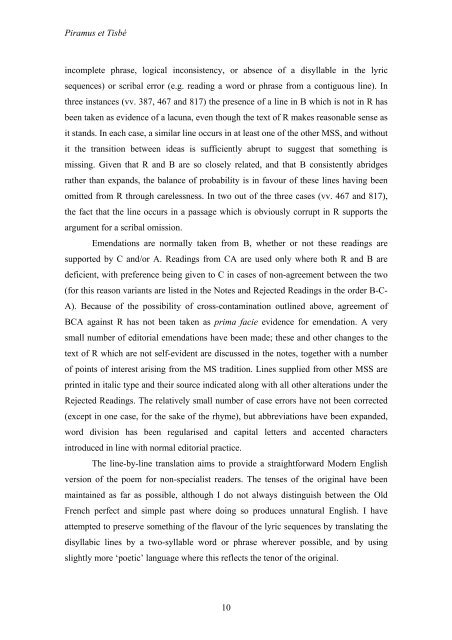Create successful ePaper yourself
Turn your PDF publications into a flip-book with our unique Google optimized e-Paper software.
Piramus et Tisbé<br />
incomplete phrase, logical inconsistency, or absence of a disyllable in the lyric<br />
sequences) or scribal error (e.g. reading a word or phrase from a contiguous line). In<br />
three instances (vv. 387, 467 and 817) the presence of a line in B which is not in R has<br />
been taken as evidence of a lacuna, even though the text of R makes reasonable sense as<br />
it stands. In each case, a similar line occurs in at least one of the other MSS, and without<br />
it the transition between ideas is sufficiently abrupt to suggest that something is<br />
missing. Given that R and B are so closely related, and that B consistently abridges<br />
rather than expands, the balance of probability is in favour of these lines having been<br />
omitted from R through carelessness. In two out of the three cases (vv. 467 and 817),<br />
the fact that the line occurs in a passage which is obviously corrupt in R supports the<br />
argument for a scribal omission.<br />
Emendations are normally taken from B, whether or not these readings are<br />
supported by C and/or A. Readings from CA are used only where both R and B are<br />
deficient, with preference being given to C in cases of non-agreement between the two<br />
(for this reason variants are listed in the Notes and Rejected Readings in the order B-C-<br />
A). Because of the possibility of cross-contamination outlined above, agreement of<br />
BCA against R has not been taken as prima facie evidence for emendation. A very<br />
small number of editorial emendations have been made; these and other changes to the<br />
text of R which are not self-evident are discussed in the notes, together with a number<br />
of points of interest arising from the MS tradition. Lines supplied from other MSS are<br />
printed in italic type and their source indicated along with all other alterations under the<br />
Rejected Readings. The relatively small number of case errors have not been corrected<br />
(except in one case, for the sake of the rhyme), but abbreviations have been expanded,<br />
word division has been regularised and capital letters and accented characters<br />
introduced in line with normal editorial practice.<br />
The line-by-line translation aims to provide a straightforward Modern English<br />
version of the poem for non-specialist readers. The tenses of the original have been<br />
maintained as far as possible, although I do not always distinguish between the Old<br />
French perfect and simple past where doing so produces unnatural English. I have<br />
attempted to preserve something of the flavour of the lyric sequences by translating the<br />
disyllabic lines by a two-syllable word or phrase wherever possible, and by using<br />
slightly more ‘poetic’ language where this reflects the tenor of the original.<br />
10
















